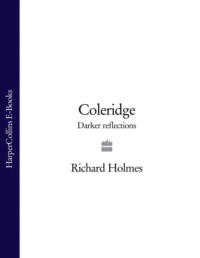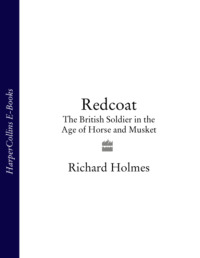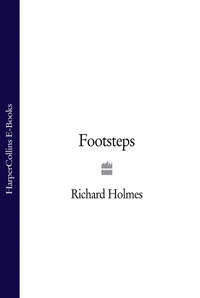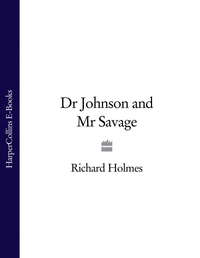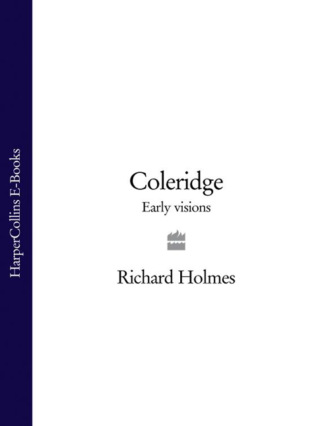
Полная версия
Coleridge: Early Visions
This odd tale, which is certainly strange enough to be true, has something curiously prophetic about it: the daydreaming poet – the sudden interruption – the accusation of (literary) theft – the hypnotic, glittering-eyed explanation. They are all emblems of the future literary man at work. The story also suggests that Coleridge was independent enough in his world of books and dreams to regularly go “skulking”, school slang for breaking bounds.
The King Street Library provided him, for two or three years, with a private larder of delights, to substitute for gifts of food.
I read through the catalogue, folios and all, whether I understood them, or did not understand them, running all risks to go skulking out to get the two volumes which I was entitled to have daily…My whole being was, with eyes closed to every object of present sense, to crumple myself up in a sunny corner, and read, read, read; fancy myself on Robinson Crusoe’s island, finding a mountain of plumb-cake, and eating a room for myself, and then eating it into the shapes of tables and chairs – hunger and fancy!13
His earliest compositions seem to have been a couple of schoolboy charms, or dog-rhymes against sickness. One was intended to ward off the dreaded “itch” that brought the sulphur treatment. The other was against morning cramps, a rhyming spell to be chanted aloud while making magic cross-marks of spittle on the seized calf muscles, “pressing the foot on the floor, and then repeating this charm with the acts configurative thereupon prescribed”.14 These were his first essays in a long line of poetical incantations.
It was the obsessive reading that first brought him to Bowyer’s fatal attentions, probably in his third year, 1785, in the Grammar School. He was then still under his junior master, the easy-going Mr Field, who had conveniently assumed that he was a daydreaming dunce. Thomas Middleton, the earnest well-meaning scholar, then a Deputy Grecian, found him reading Virgil “for pleasure” in the cloisters, and mentioned this with admiration to the headmaster. Bowyer made enquiries of Field and learned with grim interest that in class the boy was “a dull and inapt scholar” who could not repeat a single rule of syntax. Coleridge was summoned, flogged, and told that he was destined to be a Grecian. Thereafter Coleridge’s dreaming and carelessness “never went unpunished”; and whenever Bowyer beat him he would cruelly add an extra stroke, “for you are such an ugly fellow!”.15 But the gentle Middleton became henceforth Coleridge’s “patron and protector”, a significant friendship which was to continue right through to Cambridge days, and which was remembered gratefully in the Biographia, with an affectionate classical tag from Petronius.16
Coleridge’s position improved as steadily as he rose out of the most tribal ranks of the junior boys. His waywardness, cleverness, and voluble charm soon made him fast friends with two other future Grecians, Robert Allen and Valentine Le Grice, who shared the attentions of Bowyer. They formed one of those schoolboy triumvirates of contrasted talents: Bob Allen the handsome extrovert, Val Le Grice the mischievous wit, and Sam Coleridge the learned eccentric.
From 1785 he also had two of his brothers within reach in London, as Luke was training at the London Hospital under Sir William Blizard, and George came down from Oxford to teach at Newcome’s Academy in Hackney. Initially it was Luke who exercised the greatest influence, and Coleridge “became wild to be apprenticed to a surgeon”. He launched into medical and anatomy books – “Blanchard’s Medical Dictionary I had nearly by heart” – and trudged off every Saturday to attend dressings and hold plasters at the hospital. Luke’s fellow medical student, the younger brother of Admiral de Saumerez, vividly remembered the “extraordinary, enthusiastic, blue-coat boy” trailing round the wards with his endless questions.17
Another, more hair-brained, ambition at the age of fifteen was a scheme to apprentice himself to a local shoemaker, largely because the man and his wife had been so kind to him during the lonely “leave-days”. Perhaps this was a serious attempt to escape from Christ’s Hospital early (apprenticeships were, after all, allowed by the statutes), and to flee back into a less demanding, domestic existence. At all events the kindly shoemaker, a Mr Crispin, was sent packing by Bowyer after a ferocious interview – “Crispin might have sustained an action in law against him for an assault” – and Coleridge was flogged again to remind him of his privileged status as a future Grecian. “Against my will,” he recalled mournfully, “I was chosen by my master as one of those destined for the university.” But it is difficult to believe in his reluctance to excel by this stage, and the whole incident may have been one of Coleridge’s self-dramatisations – the prodigy who merely wanted to be a simple cobbler’s son, a thoroughly romantic role.18
Soon afterwards both shoemaking and medicine gave way to “a rage for metaphysics”. He read Cato on Liberty and Necessity, discovered Voltaire’s Philosophical Dictionary, and announced that he was a theological sceptic. Bowyer proved himself quite equal to this development too: “his argument was short and forcible – ‘So, sirrah, you are an infidel, are you? then I’ll flog your infidelity out of you.’”19 Coleridge often spoke of this as the severest beating of his life, though it is one of the many peculiarities of the Biographia that he afterwards pretended that Bowyer was a paragon of pedagogical justice. This is contradicted by all other records of Christ’s Hospital, even that of its official historian, who implicitly admitted that Bowyer was a sadist. Leigh Hunt quietly recalled that Bowyer not only flogged unmercifully, but picked up boys by their earlobes until they bled, and once threw a copy of Homer at him so hard that it knocked out one of his teeth. Hunt later said that Coleridge admitted all this in private, and “said he dreamt of the master all his life, and that his dreams were horrible”.20 Many Notebook entries confirm this.21
Coleridge’s genial retrospective attempt to pass off Bowyer’s cruelties in the Biographia is one of the earliest, clear examples of his urge to rewrite his personal history in a comic mode that embraced the authorities he had once rebelled against. This was to show even more sharply in his political reminiscences, where the problem of authority recurs in a different but related form. Yet the deception is a complex one, for Coleridge obviously felt genuinely indebted to Bowyer for the encouragement he was soon to give him as a fledgling poet. The truth seems to be that all his life Coleridge longed to submit to figures of authority, while at the same time he secretly resented many aspects of their domination. Casting himself in a comic role provided a sort of modus vivendi; yet he could rarely resolve the underlying conflict in his life. He longed to assert himself and give free rein to his enormous, anarchic talents; but at the same time he needed to submit, and be petted and approved of. Throughout his life, and his writing, he fluctuated wildly between these two extremes. Only his dead father, perhaps, ever allowed him to do both.
5
In spring 1787 Luke qualified as a doctor, and returned to Devon to take up a practice at Thorverton, near Exeter, where he was soon to marry. Coleridge missed him greatly – “I have now no one, to whom I can open my heart in full confidence” – and asked him to keep up “an epistolary correspondence”. In May that year he sent Luke his first serious poems, six stanzas on “Easter Holidays”, and a Latin translation which was accepted by Bowyer for the Christ’s Hospital “Album”. This was a notable distinction at the age of fourteen and a half. The theme is loneliness and misfortune, rendered in the manner of Gray:
Then without child or tender wife,
To drive away each care, each sigh,
Lonely he treads the paths of life,
A stranger to Affection’s tye…22
Bowyer promised he would be a Deputy Grecian within a year, “if I take particular care of my exercises etc”. Coleridge added that the Bowdons were still very kind to him – “I dine there every Saturday” – and that George in Hackney was now his mainstay. “He is father, brother, and every thing to me.”23 Instead of plum cake, he now asked for a copy of Edward Young’s Night Thoughts, the famous volume of the “Graveyard School”, with its celebration of solitary musings on death and mutability. Adolescence had arrived.
Over the next two years poetry, classics and Platonic philosophy became his dominant interests, as befitted a Grecian. He also discovered his own protégé, a boy called Tom Evans, whose widowed mother lived in London with three teenage daughters, soon to be extravagantly courted by Coleridge and the dashing Bob Allen. It was a time of rapid intellectual development, with long enthusiastic talks in the cloisters, alternating with lonely hours spent up on the school leads – or flat roof. Coleridge found he could secretly climb out through a Ward window and sit gazing at the sunset and the stars, with the spires and domes of the city laid out beneath him.
The taste for roof-top contemplation was one that returned to him years later, at Greta Hall in Keswick. It was there in 1802 that he recalled the first stirrings of his poetic longing, the rich self-conscious sense of beauty and isolation in the world.
In my first Dawn of Youth that Fancy stole
With many secret Yearnings on my Soul.
At eve, sky-gazing in “ecstatic fit”
(Alas! for cloister’d in a city School
The Sky was all, I knew, of Beautiful)
At the barr’d window often did I sit,
And oft upon the leaded School-roof lay…24
Coleridge often later talked of these inspired times to his friends – he described them also in “Frost at Midnight” – and it is interesting how each subtly adapted them to conform to quite different aspects of his boyhood mythology. For Wordsworth, they became the “seedtime” of a visionary poet, the “liveried schoolboy, in the depths of the huge city, on the leaded roof”, who lay alone gazing upon “the clouds moving in heaven”, and who closed his eyes to see by the “internal light” of imagination
…trees, and meadows, and thy native Stream,
Far distant, thus beheld from year to year
Of thy long exile.25
By contrast, for Charles Lamb the genius of Coleridge was not solitary at all. He saw him already as a public figure, finding his natural audience in the gregarious cloisters of Christ’s Hospital – not exiled amidst the clouds but thoroughly at home amidst a circle of admiring boys, urbane, eloquent and sociable. Lamb wrote a celebrated encomium of this schoolboy hero, a radiant figure already bursting with confidence, though perhaps comically so:
Come back into memory, like as thy wert in the dayspring of thy fancies, with hope like a fiery column before thee – the dark pillar not yet turned – Samuel Taylor Coleridge – Logician, Metaphysician, Bard! – How I have seen the casual passer through the Cloisters stand still, entranced with admiration (while he weighed the disproportion between the speech and the garb of the young Mirandula), to hear thee unfold, in thy deep and sweet intonations, the mysteries of Jamblichus, or Plotinus (for even in those years thou waxedst not pale at such philosophic draughts), or reciting Homer in his Greek, or Pindar – while the walls of the old Grey Friars re-echoed to the accents of the inspired charity boy!26
This is a very different Coleridge from the Wordsworthian exile. Nor does Elia take him entirely seriously – the Neoplatonic mystics and gnostics have the air of being plucked out of a conjuror’s hat, and there is a certain undercurrent of affectionate mockery. In the frequent “wit-combats” with Val Le Grice in the cloisters, Lamb added shrewdly that Coleridge was like a magnificent Spanish galleon – “far higher in Learning”, but wordy and cumbersome – being harried by an English man-o’-war, quick and inventive.
6
The year 1789 was a turning point for Coleridge’s whole generation. With the fall of the Bastille in July, the first tide of revolutionary excitement flooded through Europe, reaching even into the remote cloisters of Christ’s Hospital. The sixteen-and-a-half-year-old Coleridge now wrote his first substantial and original poem, “The Fall of the Bastille”. In it he records the “universal cry” of liberty from “Gallia’s shore”, and imagines the spirit of freedom reaching down even to the humble field-labourer:
…mark yon peasant’s raptur’d eyes;
Secure he views his harvests rise;
No fetter vile the mind shall know,
And Eloquence shall fearless glow…27
The excitement was indeed universal, and a hundred such Odes filled the newspapers and magazines: “bliss was it in that dawn to be alive”. Wordsworth, already at Cambridge, felt the same sudden intensification of life among the undergraduates, and planned a walking tour in France for the following summer. But perhaps Coleridge alone characteristically pointed out that language itself – “Eloquence” – had been freed.
Feeling his wings and independence for the first time, he visited Ottery during the summer, where he went through the solemn rite of recarving his initials in the Pixies’ Parlour, alongside those of his distant brothers. He learned too that his beloved sister Nancy was gravely ill, and this appears in one of his earliest sonnets, “Life”, dated September 1789, “musing in torpid woe a Sister’s pain”.28 Another sonnet, “To the Autumnal Moon”, also belongs to this period.
This quickening of the poetic impulse – he produced two more translations for Bowyer’s “Album” – reflects another outside influence. Thomas Middleton, now at Pembroke College, Cambridge, sent him a copy of the second edition of William Bowles’ Sonnets. This was one of those books, now largely forgotten, which magically captured the spirit of the times; Coleridge was so excited by it that he wrote out by hand no less than forty copies to give to friends during his last eighteen months at school.29
The collection, a slim octavo volume in fine bold print, consisted of twenty-one sonnets, “Written chiefly on Picturesque Spots, During a Tour”, which Bowles had made through Wales, Scotland, France and Germany in the previous year, while recovering from an unhappy love-affair. It concentrates notably on the evocative, melancholy feelings of seashores and river banks – the shores of Tynemouth, Dover, Ostend; the rivers Tweed, Wenbeck, Itchin, and the Rhine. Bowles, born in the West Country and a graduate of Trinity College, Oxford, exactly ten years older than Coleridge, brilliantly captured a new Romantic sense of spiritual isolation and nostalgia for childhood, projecting into natural surroundings the image of a rootless, wandering poet at the mercy of his dreams and memories.
Coleridge could instantly recognise this aspect of himself in many of the gentle, highly musical, and nakedly emotional sonnets, with their familiar imagery, such as “The Bells, Ostend”:
…And hark! with lessening cadence now they fall!
And now, along the white and level tide,
They fling their melancholy music wide;
Bidding me many a tender thought recall
Of summer-days, and those delightful years
When from an ancient tower, in life’s fair prime,
The mournful magic of their mingling chime
First waked my wondering childhood into tears!
In discovering Bowles, Coleridge found that for the first time in his life he was reading “a contemporary”; unlike the remote classics, these poems possessed an immediate reality of circumstances for him, so as to “inspire an actual friendship as of a man for a man”. They assumed “the properties of flesh and blood”.30 For the next five years, until he became aware of Wordsworth (who had also been greatly struck by Bowles, stopping to read through the entire volume while crossing London Bridge), they were the dominant influence on his own poetry, though he could only match the “austere” style – “so tender and yet so manly, so natural and real” – intermittently.
In fact throughout this period of apprenticeship there was a long struggle between the “florid diction” and epigrammatic polish and personifications of many of his longer and more formal Odes, Effusions and Monodies; and the Bowles-like plain style, expressing emotion in run-on lines, musical alliteration, and bold monosyllabic statements of personal feeling. This second style – a profound attack on eighteenth-century conventions – became particularly evident in his own shorter pieces and sonnets composed between 1789 and 1794. These included many sonnets about his own experience of change and loss, and family griefs: “To the Autumnal Moon”; “Pain”; “On Quitting School for College”; “On Receiving an Account that his only Sister’s Death was Inevitable”; and his masterpiece in the Bowles’ style (but wonderfully transforming it) “To the River Otter”.
In the Biographia he well described what he was groping after, as a poetry “of the lines running into each other, instead of closing at each couplet, and of natural language, neither bookish, nor vulgar, neither redolent of the lamp, nor of the kennel [the gutter], such as ‘I will remember thee’; instead of the same thought tricked up in the rag-fair finery of – ‘Thy image on her wing/Before my Fancy’s eye shall Memory bring.’”31 He counted Bowles’ poetry, along with the friendship of Tom Evans’ family, as the two humanising forces in his academic life as a Grecian. Between them, they drew him out of the bookish maze of metaphysics and classical philosophy, into the living world.32
7
In his happier recollections Coleridge described his final period as a Grecian, between 1790 and 1791, as “the era of poetry and love”. With Bob Allen and Val Le Grice he would escort the three Miss Evanses (Anne, Eliza, and Mary) home on a Saturday, from their milliner’s shop in the West End to the family house at Villiers Street, off the Strand. On summer mornings they would carry “the pillage of the Flower Gardens within six miles of Town with Sonnet or Love-rhyme wrapped round the Nosegay”.33
Even Bowyer’s teaching of poetry became a pleasure and fascination, according to Coleridge. “At the same time that we were studying the Greek Tragic Poets, he made us read Shakespeare and Milton as lessons…I learnt from him, that Poetry, even that of the loftiest and, seemingly, that of the wildest odes, had a logic of its own, as severe as that of science; and more difficult, because more subtle, more complex, and dependent on more, and more fugitive causes.”34
Both Lamb and Leigh Hunt deny that Bowyer’s teaching of poetry was any more than “commonplace”, and that his taste in moderns reached any higher than Pope. Perhaps Coleridge responded more subtly than they; but in reality he seems to have gained this crucial insight into the structure of poetry from his own reading of Bowles and Edward Young.*
Nevertheless he claimed too that Bowyer was an early champion of the plain style: “he showed no mercy to phrase, metaphor, or image, unsupported by sound sense…Lute, harp, and lyre, muse, muses, and inspirations, Pegasus, Parnassus, and Hyppocrene were all abominations to him.”35 Perhaps this was so; but the fact remains that his main contribution to the Christ’s Hospital “Album” for 1790 was the highly ornate “Monody on the Death of Chatterton”, packed with eighteenth-century personifications, and opening with full bardic diapason: “Now prompts the Muse poetic lays” – the very style that Bowyer was meant to abominate.
The truth seems to be that he was experimenting with every kind of poetic style and pose. His worship of Chatterton was genuine, and he had copied Bowles’ “Monody on the Death of Henry Headley” into his hymn-book to inspire him. But this did not prevent him from turning the solemn enterprise on its head with an answering “Monody on a Tea-Kettle” for George:
While Bats shall shriek and Dogs shall howling run
The tea-kettle is spoilt and Coleridge is undone!
In March 1791 he also sent his brother a Pindaric ode on Euclid’s geometry of ghastly ingenuity. His accompanying comment on learning mathematics – a thing he could never do – contains an interesting prophesy of critical debates to come: “though Reason is feasted, Imagination is starved: whilst Reason is luxuriating in its proper Paradise, Imagination is wearily travelling over a dreary desert.”36 Those images of fruitful Paradise and sterile desert were to haunt him long after.
8
Officially his career at Christ’s Hospital ended in triumph. As the senior Grecian in his year, he was awarded in January 1791 a School Exhibition worth £40 to take him to Cambridge, renewable for four years; and the following month obtained a place at Jesus College, with a promise of a Rustat Scholarship of £30, especially reserved for the sons of clergymen who showed outstanding merit. Bob Allen went to Oxford without an award, and Val Le Grice did not go up for another year. These awards delighted his family – especially George – and promised to relieve them of most of his expenses, which normally would have been more than £100 per annum.
Yet throughout that last winter Coleridge was periodically ill with rheumatic fever, contracted as a result of a late autumn bathing expedition to the New River. For several months he spent long periods in the school sanatorium, dosed with opium to help him sleep, and doing little except write some striking scraps of poetry. He lay listening to the distant shouts and laughter of the boys in the cloisters, as he recorded in his sonnet “Pain”. Coleridge’s long history of illness – often recurring in damp climates, and during winter months – now began. The sonnet is his first vision of the feverish invalid, besieged by “the trembling sense of wan Disease”, cut off from the normal, healthy daylight world around him, a theme to be powerfully developed.37
He also wrote a love-poem, “Genevieve”, addressed to his young nurse, whose short lyrical lines contain the first hint of the ballads he would later write. They praise her tender solicitude and generous, maternal bosom in its starched apron like a swan:
When sinking low the sufferer wan
Beholds no hand outstretch’d to save,
Fair, as the bosom of the Swan
That rises graceful o’er the wave,
I’ve seen your breast with pity heave,
And therefore love I you, sweet Genevieve!38
The close association of poetry with sickness, feverish dreams, and isolation, set against the consoling, healing presence of the beloved, was now initiated. The theme was deepened by tragic sickness in his own family. Early in 1791 came news of Luke’s sudden death of a fever at Exeter; and this was quickly followed by the death of his beloved Nancy, after a long consumptive illness. Again, Coleridge turned to poetry, writing several more sonnets of deep and clumsy emotion:
Pain after pain, and woe succeeding woe –
Is my heart destin’d for another blow?
O my sweet sister! and must thou too die?39
Significantly, he already linked these deaths with that of his father, and the sense of being “fated to rove thro’ Life” bereft of those who had been closest to him in childhood. Perhaps this also explains the intense emotion with which he finally left Christ’s Hospital that summer, celebrated in his “Sonnet: On Quitting School for College” (another theme taken from Bowles). He bid “Adieu, adieu!” to the “much-lov’d cloisters pale!”, and spoke in tears of his happy days there, most of which he would later say were miserable.40
Конец ознакомительного фрагмента.
Текст предоставлен ООО «ЛитРес».
Прочитайте эту книгу целиком, купив полную легальную версию на ЛитРес.


